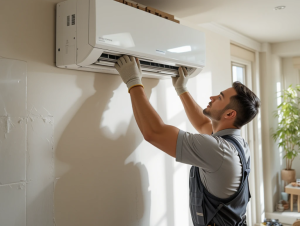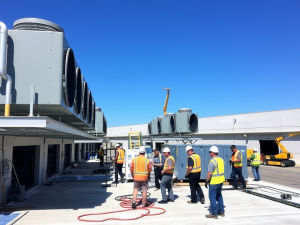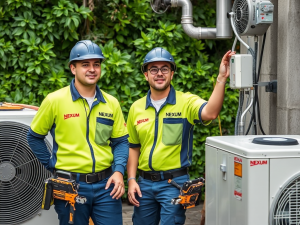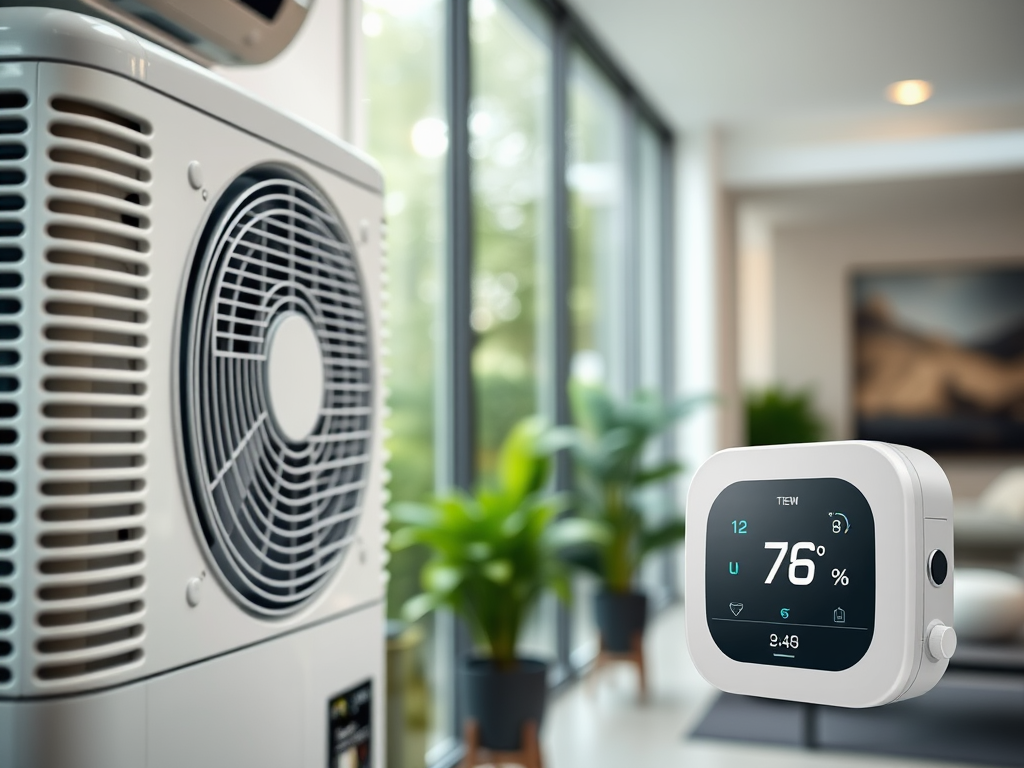Top Mini Split AC Installation Services
Mini Split AC Installation is a modern, energy-efficient solution for homeowners and business owners looking to cool specific areas without the hassle of ductwork. Unlike traditional systems, mini splits offer flexible zoning, quiet operation, and lower energy consumption making them ideal for room additions, older homes, or spaces with unique cooling needs. Whether you’re upgrading your current system or planning a new installation, understanding how mini splits work can help you make a smart, long-term investment in comfort and efficiency.
Installing a Mini Split AC system is a smart way to cool your home or business with efficiency and precision. Unlike traditional systems that require bulky ductwork, mini splits offer a cleaner, more targeted approach. Whether you’re cooling a single room or multiple areas, this system delivers flexibility, energy savings, and quiet comfort.
Let’s walk through everything you need to know before making the switch.
What Is a Mini Split AC System?
A mini split air conditioner, also known as a ductless AC, consists of an outdoor compressor unit and one or more indoor air handlers. These components are connected by a narrow conduit that houses the power cable, refrigerant tubing, and drain line.
What makes this system so appealing is its ductless design. By removing the need for ducts, the system not only saves space but also reduces energy loss, which is common in ducted setups. People searching for ductless mini split AC installation services usually want better control over their cooling zones while lowering their utility bills.
Mini splits come in various capacities, making them suitable for homes, small offices, garages, and even apartments.

Major Types of Mini Split AC Systems
Mini split AC systems come in a variety of types to suit different spaces, needs, and installation preferences. While all mini splits share a ductless design and energy-efficient operation, their configurations vary based on how the indoor unit is installed and how many zones they support. Below are the major types of mini split AC systems used in the USA:
Wall-Mounted Mini Split AC
This is the most common and affordable type. The indoor unit is mounted high on a wall and blows air directly into the room. It’s ideal for bedrooms, living rooms, offices, or small commercial spaces.
Best for:
Easy installation
Efficient cooling in single-zone spaces
Homeowners on a budget
Ceiling Cassette Mini Split
This type is recessed into the ceiling, with only the grille visible. It distributes air in four directions, making it great for larger or open-concept areas.
Best for:
Large rooms
Aesthetic appeal (discreet appearance)
Offices and commercial areas
Floor-Mounted Mini Split
Mounted close to the floor, this unit looks similar to a radiator. It’s perfect for rooms with low ceilings, sloped walls (like attics), or limited upper wall space.
Best for:
Attics and sunrooms
Rooms with limited wall height
Elderly or accessibility needs (easy to reach)
Ceiling Suspended Mini Split
This unit hangs from the ceiling and is ideal for spaces where wall or floor installation isn’t practical. It’s commonly used in restaurants, stores, and commercial buildings.
Best for:
Commercial spaces
High-ceiling areas
Rooms without usable wall or floor space
Multi-Zone Mini Split Systems
Unlike single-zone systems that connect one indoor unit to one outdoor unit, multi-zone systems allow multiple indoor units to connect to a single outdoor compressor. Each indoor unit can be controlled independently.
Best for:
Whole-home cooling
Homes with multiple rooms needing separate temperature control
Energy savings from customized use
Who Needs a Mini Split AC?
Mini split systems are ideal for those who need focused cooling or want to supplement an existing
HVAC system. For example, if you’ve recently converted your attic, added a sunroom, or finished your basement, running new ducts can be expensive and invasive. A mini split is a perfect solution in these cases.
Many homeowners who search for mini split AC installation near me are looking for simple, effective systems that don’t require a complete overhaul of their existing heating and cooling setup. These units also appeal to renters or landlords seeking affordable, reversible installations.
If you’re a business owner, this solution can work just as well. Which brings us to commercial use.

Benefits of Installing a Mini Split AC
Mini splits offer several compelling advantages over traditional air conditioning systems. One of the biggest draws is zoned cooling you can set different temperatures in different rooms. That means no more overcooling empty spaces.
They also help reduce energy bills. Since there’s no ductwork, there’s no energy loss through leaks or poorly insulated airways. Installation is also quicker and requires less construction mess.
Additional benefits include:
Quiet operation indoors and outdoors
Sleek unit designs that blend with interiors
Both cooling and heating capabilities in most models
Businesses looking into commercial AC installation often appreciate these benefits, especially in environments like offices or retail stores where customer comfort and energy efficiency matter.
Mini Split AC Installation: Step-by-Step Process
Installing a mini split system involves planning and precision. The process begins with selecting the appropriate unit based on room size and cooling needs. An HVAC technician will assess the space to determine BTU requirements and suggest how many zones (indoor units) are needed.
Next, the indoor unit is mounted on the wall, typically near the top where airflow can circulate effectively. A small hole is drilled through the wall for the refrigerant line and power cable, connecting the indoor and outdoor units.
Once connected, the installer vacuums the lines to remove moisture, charges the system with refrigerant, and runs tests to ensure optimal performance. The whole process can take a few hours for a single-zone system, or a full day for larger, multi-zone setups.
In hotter climates, it’s common to see people look up AC installation Flower Mound to find local installers who understand the unique cooling demands of Texas. Meanwhile, coastal residents often search for AC installation Oceanside to deal with the area’s salt air and humidity challenges.
Can You DIY Mini Split Installation?
Although DIY kits are available, installing a mini split AC system yourself is not recommended for most homeowners. These systems involve high-voltage electrical work, precise refrigerant handling, and drilling through walls. If not done properly, it can void your warranty, compromise system performance, or even pose safety hazards.
Licensed technicians are trained to avoid these risks, ensuring a safe and long-lasting setup. If you’ve ever searched ductless AC installation near me, it’s because professional help truly matters when dealing with such systems.
How Much Does Mini Split AC Installation Cost?
The cost of installation varies based on the number of zones, the brand of the unit, the complexity of the project, and local labor rates. On average, a single-zone system is more affordable and straightforward, while multi-zone setups cost more due to additional wiring and units.
Typical costs may include:
Unit price
Labor charges
Wall modifications (if needed)
Electrical upgrades (for older homes)
When homeowners research ductless mini split AC installation cost, they’re often looking for a clear idea of total expense. It’s wise to get a written quote and breakdown of all expected costs from your installer.
Common Mistakes to Avoid During Installation
Mini split systems are efficient when installed correctly. But even a small error can affect performance. One of the most common mistakes is choosing the wrong size unit—either too small to cool the space or too large, which leads to short cycling and higher energy bills.
Other mistakes include:
Installing the indoor unit where furniture blocks airflow
Not vacuuming the refrigerant lines before charging
Skipping necessary permits or code compliance
In cities like Seattle, many homes are compact and require thoughtful planning. Hiring a qualified AC installation Seattle provider ensures your setup is code-compliant and optimized for your space.
Maintenance Tips After Installation
Once your mini split system is installed, maintaining it is relatively simple. Regular upkeep ensures the system runs efficiently and lasts longer. Filters should be cleaned or replaced monthly, especially during peak seasons. The indoor and outdoor units should be checked yearly for debris, dust, and coil condition.
Professional tune-ups once a year are also recommended. Even the best-rated mini-split AC unit installer in Ventura California will tell you that preventive care is the secret to long-lasting performance.
Why Hire a Professional Installer?
Professional installation brings peace of mind. Certified installers ensure correct sizing, safe electrical connections, and proper refrigerant handling. You’ll also avoid voiding the warranty, which often happens with self-installed systems.
Many reputable HVAC companies provide an AC installation free estimate, helping you budget without pressure. It’s also helpful to choose a provider who offers both AC installation and repair, so you’re covered if issues arise later.
Look for technicians offering AC repair and installation services together—this means you’ll always have a go-to expert who understands your system.

FAQs Section
How to install a mini split AC?
Installation involves mounting the indoor unit, placing the outdoor condenser, drilling a hole for the refrigerant line, and connecting wiring, tubing, and drainage. Final steps include vacuuming the lines and testing the system.
Can I install a mini split system myself?
While some kits are labeled DIY, it’s strongly recommended to hire a licensed HVAC technician to ensure proper sizing, electrical safety, and to preserve the system’s warranty.
How much does it cost to install a new mini split?
On average, it costs between $2,000 and $8,000 depending on the number of zones, system size, and labor rates in your area.
What are the disadvantages of a mini split system?
Initial installation cost can be high, the wall units are visible, and installation requires professional tools and experience for best results.
Do I need an electrician to install a mini split?
Yes, especially for connecting high-voltage power and ensuring code compliance. Many HVAC companies work with licensed electricians for this reason.
Where not to install a mini split?
Avoid installing in enclosed closets, directly above heat sources, or in areas where airflow is blocked by furniture or walls.
Are mini splits expensive to run?
No, they are generally energy-efficient and cost less to run than central systems due to zoned cooling and no duct loss.
How many mini splits for a 3-bedroom house?
Typically, 3 to 4 indoor units are needed—one for each bedroom and a shared unit for the living space, depending on layout and insulation.
How much electricity does a mini split use?
A single-zone mini split typically uses 500–700 watts per hour, but this varies by model, settings, and usage habits.
Can a mini split cool a whole house?
Yes, with a multi-zone system. You can install several indoor units connected to one outdoor unit to effectively cool an entire home.
Conclusion
A mini split AC system is a flexible and efficient way to cool your home or business. With quick installation, lower utility costs, and customizable comfort, it’s an upgrade worth considering. Whether you’re in Flower Mound, Oceanside, Ventura, or Seattle, there’s a solution that fits your needs and budget.
Contact us today for expert advice, professional installation, and a free estimate on your Mini Split AC Installation project.




